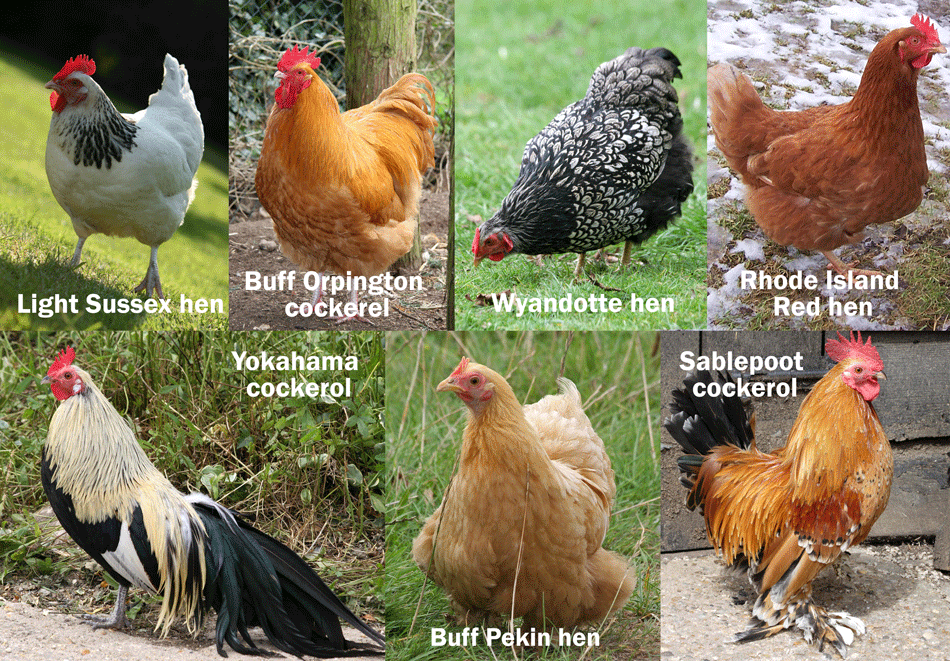
When considering keeping poultry for the first time, your motivations behind this decision will influence the breed or type of chickens you choose. If you just want plenty of decent-sized eggs, then commercial breeds or hybrids are probably your best bet and these include Goldlines, Black Rocks and Rhode Island Reds. You could also consider rehoming some battery hens which, although considered no longer commercially viable, soon adapt to “normal” life and can go on laying for years.
If you also want your birds to be decorative, then you may wish to consider pure breeds which come in a variety of colours and plumage “arrangements” and often in both “standard” and bantam sizes! Silkies, for example, have almost fur-like feathers and can have bearded (pom-pom-like) heads along with feathers on their legs, though these can become muddy and bedraggled-looking in wet weather. Being smaller, bantams are ideal where space is limited, although they do lay smaller eggs, and, if you want coloured eggs, choose Araucana or Cream Legbars (greenish blue eggs), Marans or Welsummers (dark brown eggs) or Leghorns for white eggs.
You don’t need a cockerel for your hens to lay eggs so, if you, or your neighbours, don’t fancy being woken by crowing every morning, you’re in luck! They usually reach “point of lay” at the age of 18 to 20 weeks, when they are known as “pullets”, and will reach the peak of their egg-laying ability at about 2 years of age with commercial breeds laying up to 300 eggs per year. This will tail off from around the age of 4, with most chickens living for 7 to 10 years and some into their teens.
Feeding Your Chickens
Like all creatures, chickens do best on a balanced diet supplying a full range of nutrients. Those who are free range, or who have access to the outdoors, will be able to supplement this with worms, beetles and herbage but are still best fed a specially formulated compound feed to provide a balance of protein, carbohydrates, vitamins and minerals. Layers’ pellets (Fancy Feed Layers' Pellets) are generally considered the most convenient fully balanced poultry feed, although mash is also available but this can be a little messy and, if too fine, can be difficult for the birds to swallow.
Like all creatures, chickens do best on a balanced diet supplying a full range of nutrients. Those who are free range, or who have access to the outdoors, will be able to supplement this with worms, beetles and herbage but are still best fed a specially formulated compound feed to provide a balance of protein, carbohydrates, vitamins and minerals. Layers’ pellets (Fancy Feed Layers' Pellets) are generally considered the most convenient fully balanced poultry feed, although mash is also available but this can be a little messy and, if too fine, can be difficult for the birds to swallow.
In addition to layers’ pellets, you can give wheat, cut maize or mixed corn (Fancy Feed Mixed Corn) which supply carbohydrate calories but are not a complete feed like the pellets. Ideally, you should give your birds their compound feed (pellets) in the morning, when they are hungry, to ensure they consume a balance of nutrients, and save corn for the afternoon. The calories provided by the corn as it is digested overnight, will help keep them warm so is particularly important during the winter months. Other treats, like vegetable and fruit scraps, are also welcomed and of more importance to confined birds than those which free range.
One thing to be aware of is that chickens moult about once a year, when they renew all their feathers over a period of 8 to 10 weeks. Most will stop laying altogether during this period, which is generally during the autumn months, though some will continue reduced egg production. This is a time of high nutritional demand for the chicken so it is important to maintain their balanced diet. For the heavily feathered birds it may even be worth changing to a specially formulated breeding and showing diet (Fancy Feed Breeder & Show Pellets) to supply the extra nutrients required for strong healthy plumage.
It is best to give your compound feed in specially designed feeder in order to reduce mess and wastage and avoid attracting vermin. Whatever feeder you use, it needs to be covered or inside the chicken house to keep it out of the rain and the reach of wild birds, as well as being easily accessed for topping up and cleaning. If at all possible, it is worth removing uneaten feed once the hens have had their fill, as it is likely to attract rats and other vermin which may also have a go at the chickens themselves. Water should be changed daily and containers raised, for preference, to stop the hens scratching dirt into them. In the winter, it may be advisable to empty water containers at night, when the hens are shut up, so that they don’t become frozen solid and can easily be filled in the morning.
For information and advice contact The Fancy Feed Company on 01371 850247.
